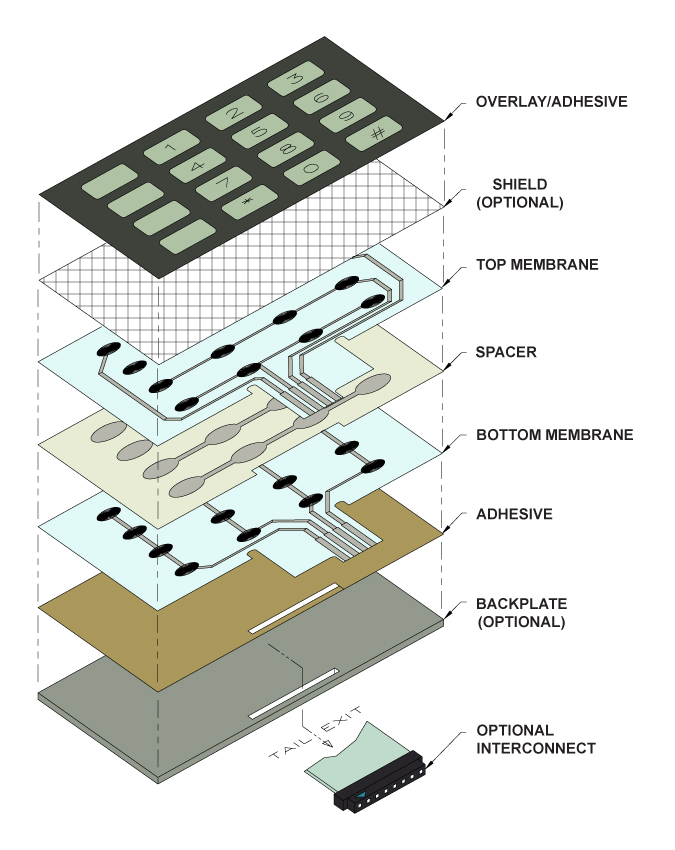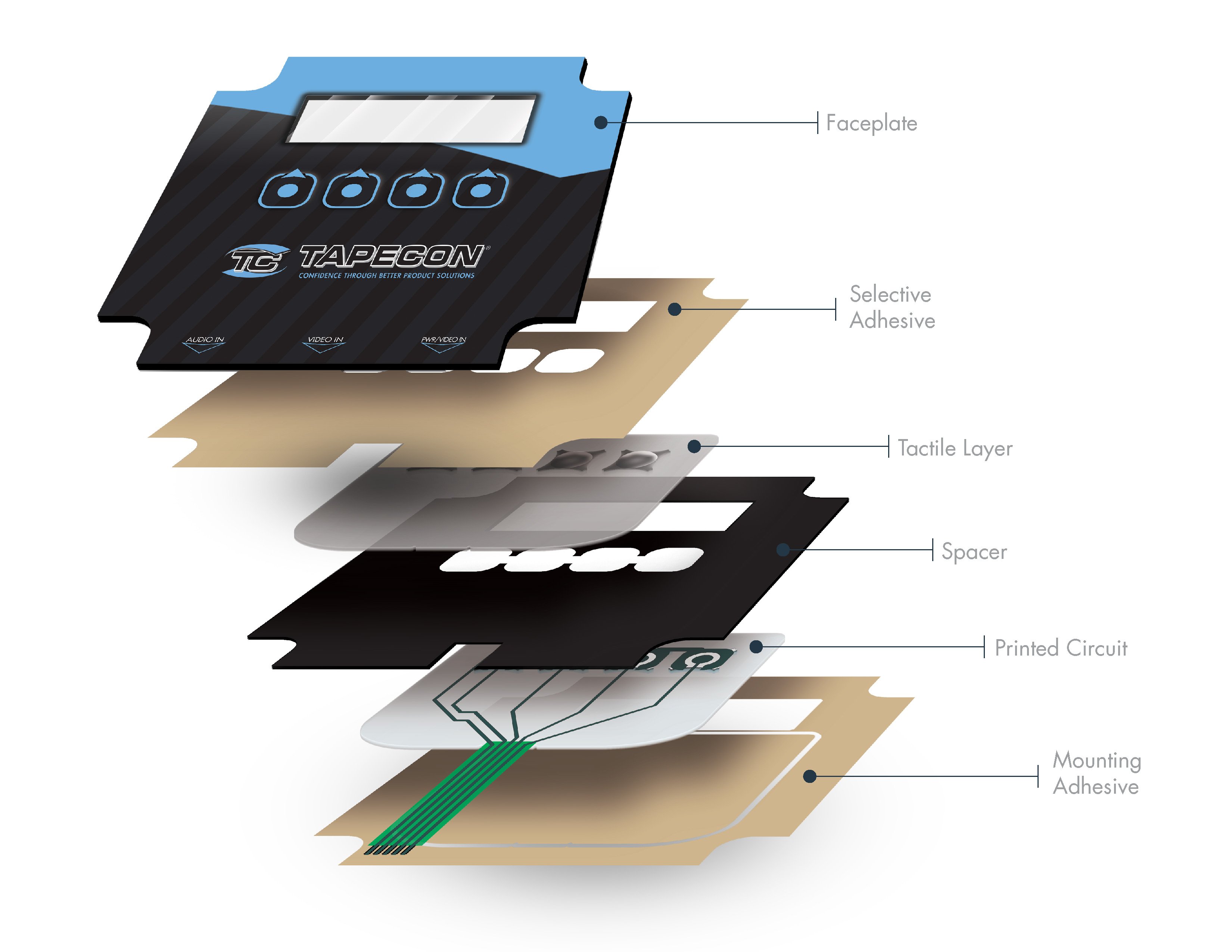Membrane Switch Manufacturer Focused on User-Friendly Design
Wiki Article
Recognizing the Importance of Membrane Switch in Modern Electronics and Their Applications
Membrane switches act as an essential component in modern-day electronic devices, offering a reliable user interface for customer interaction. Their adjustable and light-weight nature makes them ideal for an array of applications throughout varied sectors. Recognizing their key components and benefits can provide insights into their growing significance. As innovation continues to development, the development of Membrane changes increases concerns regarding their future applications and design developments. What lies in advance in this vibrant field?
What Are Membrane Buttons?
Membrane switches are vital elements in modern electronics, offering as user interfaces that facilitate communication in between individuals and gadgets. These buttons are composed of a number of layers, including a graphic overlay, a glue layer, and a circuit layer, every one of which work together to produce a long lasting and useful user interface. The layout permits for a flat, low-profile remedy that can be personalized concerning size, form, and aesthetic appearance, making them ideal for different applications, from consumer electronic devices to medical tools. The tactile feedback offered by Membrane switches boosts user experience, while their resistance to dirt and moisture makes them perfect for testing environments. Furthermore, Membrane switches can integrate attributes such as backlighting and published graphics, additionally increasing their functionality. Their flexibility and effectiveness make them a preferred choice in markets where integrity and ease of use are extremely important, inevitably adding to the seamless operation of modern digital tools.Secret Parts of Membrane Switches
While different components add to the performance of a membrane layer switch, 3 primary layers play considerable duties in its layout and procedure. The top layer, commonly made from a resilient polymer, acts as the interface for individual communication, frequently featuring published icons and graphics. Under this is the spacer layer, which keeps the necessary distance between the top layer and the circuit layer. This spacer layer assurances that the switch turns on only when pressed, preventing unexpected inputs. Ultimately, the circuit layer contains conductive traces that finish the electrical circuit when the leading layer is depressed. These traces can be made from different materials, consisting of copper or silver. With each other, these components produce a durable and reliable tool that is compact and flexible, ideal for a variety of digital applications, from house appliances to medical tools. Understanding these key components is vital for appreciating the total performance of Membrane switches.Advantages of Making Use Of Membrane Switches

Membrane Switch Production Process
Recognizing the Membrane switch manufacturing process reveals the elaborate actions included in creating these important components. The procedure normally starts with the style phase, where requirements and layouts are created using specialized software application. Following this, the visuals overlay is published on a versatile substrate, commonly making use of high-resolution printing strategies to guarantee clarity and precision.Next, the adhesive layers are used, which offer to bond the numerous elements together. The circuit layers, made from conductive inks or materials, are then printed onto a separate substratum. These layers are very carefully straightened and laminated to create a practical switch.After setting up, the switches undergo checking to verify functionality and sturdiness. Quality control procedures are carried out throughout the process to identify and fix any kind of flaws. The finished Membrane switches are packaged and prepared for circulation, prepared to fulfill the demands of modern electronic applications.Applications of Membrane Changes in Various Industries
Membrane switches are significantly used throughout different industries, especially in medical devices and customer electronics. In the clinical field, they give reliable control interfaces for tools that need specific operation. In a similar way, in consumer electronics, these buttons enhance individual communication by providing streamlined and responsive user interfaces.
Medical Devices Control
Countless modern medical gadgets make use of Membrane switches for streamlined operation and boosted user communication. These buttons give a trustworthy, durable interface for a range of applications, including diagnostic devices, patient monitoring systems, and surgical instruments. Their adjustable styles enable for certain layouts that can fit the one-of-a-kind demands of medical care professionals, ensuring intuitive navigation and efficient access to necessary features. In addition, check my source Membrane switches are resistant to contaminants, making them appropriate for sterilized atmospheres. The tactile feedback they offer can improve customer self-confidence, lowering the danger of mistakes during vital clinical treatments. Generally, the combination of Membrane buttons in clinical tools substantially contributes to improved functional performance and individual security in healthcare setups.Consumer Electronic Devices Interfaces
In the domain name of consumer electronics, Membrane switches play a vital function in enhancing user interfaces throughout a variety of tools. These switches are essential to items such as remote controls, microwaves, and gaming consoles, providing a effective and straightforward user interface. Their design enables a smooth integration of graphics and capability, enabling suppliers to create streamlined, modern visual appeals without jeopardizing use. Membrane buttons are also understood for their sturdiness, often standing up to extensive usage and exposure to numerous ecological conditions. Furthermore, they can include features like backlighting and responsive feedback, additional enhancing the customer experience. As consumer demands for advanced yet instinctive user interfaces grow, Membrane switches over remain to be a necessary component beforehand electronic gadget performance.Style Factors To Consider for Membrane Switches
Designing effective Membrane changes needs cautious attention to different aspects that influence both capability and individual experience. One important consideration is the option of products, as they can influence longevity, tactile comments, and visual appeal. Picking a suitable adhesive is crucial for assuring long-term adhesion and resistance to ecological factors.In addition, the design and design of the switch must accommodate user communication, with switch sizes and spacing maximized for convenience of usage. The consolidation of graphics and labeling ought to prioritize clarity and presence under numerous illumination conditions.Consideration of electric attributes, such as actuation force and switch level of sensitivity, will certainly improve the responsiveness of the Membrane button. The design needs to suit producing procedures to ensure cost-effectiveness and timely manufacturing. Generally, a well-thought-out layout boosts both the customer and the performance experience of Membrane buttons in modern electronic devices.
Future Trends in Membrane Switch Technology
As modern technology continues to progress, Membrane switches are poised to integrate brand-new developments that will certainly enhance their performance and application in numerous fields. One considerable fad is the unification of flexible and durable materials, which will certainly raise the lifespan and dependability of these switches. Improved surface area appearances and customizable graphics are also expected, permitting for even more intuitive individual interfaces.Moreover, the assimilation of clever technology, such as touch-sensitive surfaces and haptic feedback, is expected to improve individual interaction, making Membrane changes extra appealing and receptive. Furthermore, advances in published electronic devices will certainly make it possible for extra complex wiring within thinner accounts, further expanding layout possibilities.Sustainability will likewise play an essential duty in future growths, as suppliers discover eco-friendly products and manufacturing procedures. In general, these trends will assure that Membrane switches remain pertinent and indispensable in a significantly electronic and interconnected globe.Frequently Asked Questions
Just How Do Membrane Switches Compare to Standard Mechanical Switches?
Membrane switches offer benefits over conventional mechanical switches, including lowered dimension, lighter weight, and improved resilience. They generally provide a secured surface, boosting resistance to dust and dampness, making them optimal for diverse applications.What Products Are Typically Made Use Of in Membrane Switch Building?

Can Membrane Switches Over Withstand Extreme Environmental Conditions?
Membrane buttons can withstand severe ecological conditions, relying on their design and products. High-grade building and constructions frequently include durability versus temperature changes, humidity, and direct exposure to chemicals, making them appropriate for numerous demanding applications throughout industries.How Much Time Do Membrane Switches Usually Last Before Failing?
Membrane switches over commonly display a life expectancy varying from 1 to 10 additional info million actuations, depending upon factors such as usage frequency, ecological conditions, and producing top quality. Regular maintenance can extend their resilience and operational integrity considerably.Are Membrane Changes Personalized for Certain Applications?
Membrane switches are indeed personalized for particular applications. They can be customized in capability, layout, and dimension, enabling suppliers to fulfill unique user requirements and boost product aesthetic appeals while preserving functional performance and resilience. Membrane buttons are essential elements in modern electronic devices, offering as individual interfaces that promote interaction between devices and customers. The responsive feedback supplied by Membrane switches improves individual experience, while their resistance to dust and moisture makes them ideal for testing atmospheres. The incorporation of graphics and labeling need to prioritize clearness and presence under numerous lights conditions.Consideration of electric attributes, such as actuation force and button level of sensitivity, will certainly boost the responsiveness of the Membrane button. Enhanced surface area structures and personalized graphics are additionally anticipated, allowing for more intuitive user interfaces.Moreover, the integration of clever innovation, such as touch-sensitive surface areas and haptic feedback, is expected to improve individual communication, making Membrane switches over extra appealing and receptive. Membrane switches over offer benefits over standard mechanical switches, including reduced size, lighter weight, and improved resilience.Report this wiki page